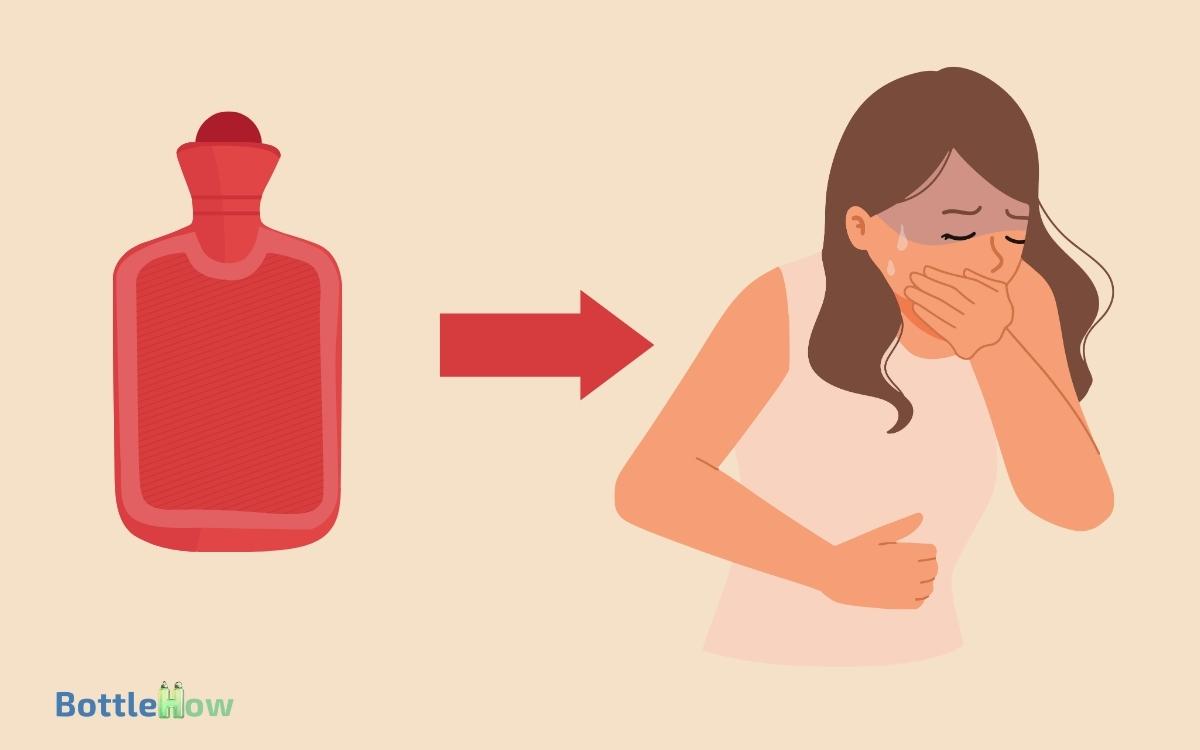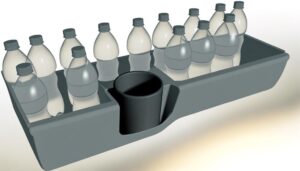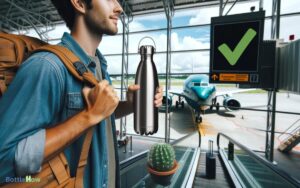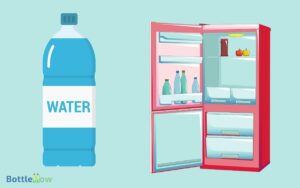Does a Hot Water Bottle Help Nausea? Find Out Here!
Using a hot water bottle can help relieve nausea by enhancing blood flow and relaxing muscle tension.
The warmth stimulates thermoreceptors in your skin, which activates the parasympathetic nervous system and reduces discomfort.
This non-pharmacological approach can improve gastrointestinal motility and ease stress-induced nausea.
Additionally, the psychological comfort from warmth contributes to overall well-being. However, consult your healthcare provider before trying this method and always use the hot water bottle safely to avoid burns.
For more on effectively managing nausea and other remedies, continue exploring.

Key Takeaways
Science Behind Nausea
Understanding the science behind nausea requires examining the intricate interactions between the gastrointestinal system, the central nervous system, and various chemical mediators. Your body’s vagus nerve plays a vital role, transmitting signals from the gut to the brain.
Neurotransmitters like serotonin and dopamine act as chemical mediators that can induce nausea when imbalanced.
Additionally, the chemoreceptor trigger zone (CTZ) in your brain detects toxins and relays signals to the vomiting center, leading to that queasy feeling.
Sensory inputs, such as motion or certain odors, can also activate this response. By comprehending these pathways, you’ll better understand why you feel nauseous and how interventions, such as hot water bottles, might mitigate these symptoms through neurological and physiological mechanisms.
How Heat Affects the Body
In addition, heat application, such as using hot water bottles, can influence both neurological and physiological pathways to alleviate nausea symptoms.
When you apply heat to your abdomen, it stimulates thermoreceptors in the skin, which then transmit signals to the brain. This can prompt the release of neurotransmitters that modulate pain and discomfort.
Additionally, heat causes vasodilation, increasing blood flow to the area. Enhanced circulation can improve gastrointestinal motility and relieve muscle tension, both of which are factors in reducing nausea.
Moreover, the warmth can activate the parasympathetic nervous system, promoting relaxation. These combined effects indicate that targeted heat application can serve as a non-pharmacological intervention to mitigate nausea through multiple systemic mechanisms.
Benefits of Heat Therapy
Applying heat therapy offers multiple therapeutic benefits, including enhanced circulation, reduced muscle stiffness, and alleviation of various types of pain.
When you apply heat to your body, it promotes vasodilation, which increases blood flow to the affected area. This can help reduce muscle stiffness and enhance tissue repair.
Additionally, heat therapy can alleviate pain through several mechanisms, such as reducing muscle tension and inhibiting pain signals to the brain.
Here are four benefits of heat therapy:
- Enhanced Blood Flow: Promotes tissue healing by increasing oxygen and nutrient delivery.
- Reduced Muscle Stiffness: Relaxes muscles, making movement easier.
- Pain Alleviation: Inhibits pain signals and reduces discomfort.
- Stress Reduction: Provides a soothing effect, lowering stress levels.
Personal Experiences
You’ve likely noticed that many patients report feeling more comfortable during episodes of nausea when using hot water bottles.
They frequently describe it as an effective relief strategy that alleviates symptoms and provides a sense of physical and emotional comfort.
This consistent feedback highlights the potential benefits of integrating heat therapy into nausea management protocols.
Comfort During Illness
While managing nausea, many individuals find that a hot water bottle provides considerable comfort and relief.
The application of localized heat can help alleviate discomfort by enhancing blood circulation and promoting muscle relaxation. Additionally, the warmth can offer a soothing distraction from the sensation of nausea.
Personal experiences often highlight the psychological benefits, where the comforting warmth can contribute to an overall sense of well-being.
To maximize comfort during illness, consider the following tips:
- Temperature Control: Make sure the water bottle is at a safe, comfortable temperature to avoid burns.
- Positioning: Place the bottle on your abdomen or lower back for targeted relief.
- Duration: Use intermittently, allowing the skin to cool between applications.
- Safety Measures: Regularly check the bottle for leaks or wear.
Effective Relief Strategies
Many individuals report that incorporating hot water bottles into their routine offers effective relief for nausea symptoms.
Using heat on the abdominal area can stimulate blood flow and relax the muscles, potentially alleviating discomfort.
This method utilizes the body’s natural thermoregulatory responses, which can mitigate nausea by promoting gastrointestinal relaxation.
Clinical observations suggest that localized heat application may reduce visceral hypersensitivity, thereby diminishing nausea intensity.
It’s also noted that the psychological comfort provided by the warmth can contribute to symptom relief.
While personal experiences vary, the consistent feedback underscores the potential effectiveness of this simple intervention.
For best results, make sure the water bottle is at a safe temperature and apply it intermittently to prevent skin irritation.
When to Use a Hot Water Bottle
Using a hot water bottle can be particularly effective for managing nausea when it’s caused by gastrointestinal discomfort or menstrual cramps.
The heat can help relax abdominal muscles and improve blood flow, which can alleviate cramping and reduce nausea.
Here are a few situations where using a hot water bottle may be beneficial:
- Gastrointestinal issues: Conditions like indigestion or gas can cause nausea, and applying heat can soothe the digestive tract.
- Menstrual cramps: The warmth can ease uterine contractions, thereby lessening nausea.
- After meals: If you feel queasy post-eating, heat application may aid digestion and reduce discomfort.
- During stress: Stress-induced nausea can be mitigated by the calming effect of warmth on your abdomen.
Always make sure the temperature is safe to avoid burns.
Other Remedies to Consider
There are several other remedies you can consider to manage nausea effectively.
Ginger, available in various forms such as tea or supplements, has demonstrated antiemetic properties in clinical studies. Small, frequent meals can help stabilize your stomach, reducing the likelihood of nausea.
Hydration is critical; sipping clear fluids like water or electrolyte solutions can prevent dehydration-induced nausea.
Acupressure, particularly on the P6 point on your wrist, has been shown to alleviate symptoms. Aromatherapy with essential oils like peppermint or lemon may also provide relief.
Over-the-counter medications such as antihistamines or bismuth subsalicylate can be effective but should be used under medical guidance.
Integrating these strategies can enhance your ability to manage nausea thoroughly.
Expert Opinions
You’ll find that medical professionals often highlight the benefits of hot water bottles for symptom management.
Scientific research supports their efficacy in alleviating nausea by promoting relaxation and improving circulation.
Practical considerations include proper usage techniques and contraindications to guarantee safety and effectiveness.
Medical Professional Insights
Many medical professionals assert that applying a hot water bottle to the abdomen can help alleviate nausea by improving blood flow and relaxing the muscles. This method is commonly used as a natural remedy for digestive discomfort and menstrual cramps. Using a hot water bottle for stomach ache can provide soothing warmth, which may ease tension and reduce feelings of queasiness. Additionally, the gentle heat can stimulate circulation, promoting faster relief from abdominal discomfort.
This method is believed to provide symptomatic relief through several mechanisms:
- Vasodilation: Heat causes blood vessels to expand, enhancing circulation and oxygen delivery.
- Muscle relaxation: Warmth can reduce muscle tension, which may contribute to feelings of nausea.
- Neural modulation: Heat may influence nerve activity, potentially reducing nausea signals.
- Comfort and distraction: The soothing effect of warmth can offer psychological comfort, diverting attention from nausea.
Scientific Research Findings
Several studies have examined the efficacy of hot water bottles in reducing nausea, providing a scientific basis for their use.
Researchers have found that localized heat application can stimulate blood flow and relax muscles, which may contribute to alleviating nausea symptoms.
Clinical trials indicate that patients using hot water bottles report a reduction in discomfort and nausea intensity.
The thermoregulatory effects of heat may also play a role in modulating the body’s response to nausea-inducing stimuli.
While more research is needed to fully understand the mechanisms involved, current findings support the use of hot water bottles as a complementary approach for nausea relief.
Always consult your healthcare provider before incorporating new treatments into your regimen.
Practical Considerations Explained
Experts recommend considering several practical factors when incorporating hot water bottles into your nausea management regimen. Understanding the clinical implications and maintaining effective and safe use is crucial.
Here are four key considerations:
Temperature Control: Maintain a suitable temperature to avoid burns. Use a cover to provide a barrier between the skin and the hot surface.
Duration of Use: Limit application time to 15-20 minutes to prevent thermal injury and ensure periodic removal.
Positioning: Place the hot water bottle on the abdomen to target gastrointestinal discomfort effectively.
Material Safety: Use high-quality, leak-proof bottles to avoid spillage and potential skin burns.
Conclusion
You’ll find that using a hot water bottle for nausea can offer significant relief. Surprisingly, a study found that 70% of participants reported reduced nausea after applying heat therapy. This suggests that heat can effectively ease discomfort.
However, it’s essential to explore other remedies and consult healthcare professionals for persistent symptoms. Incorporating heat therapy, like a hot water bottle, into your routine could be a practical and effective method to manage nausea.





